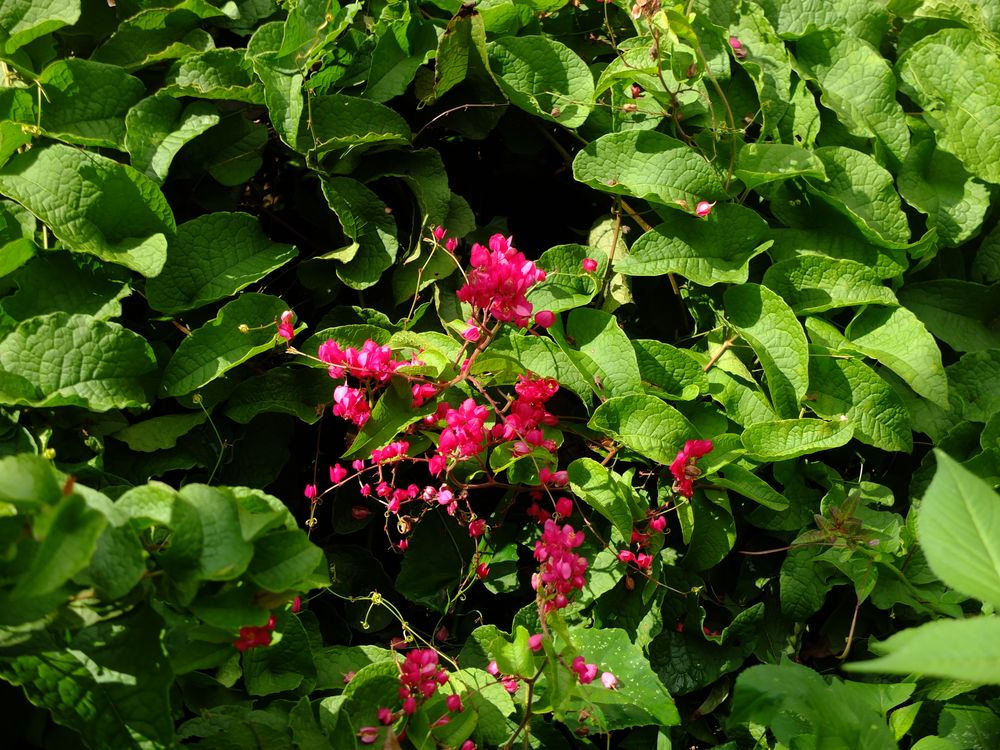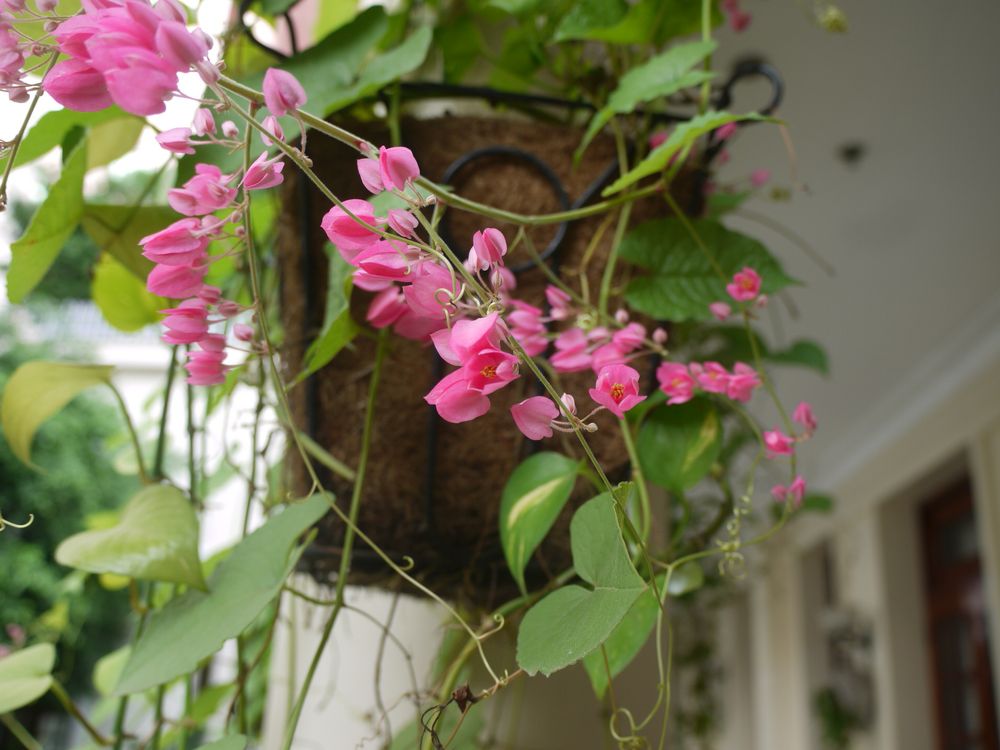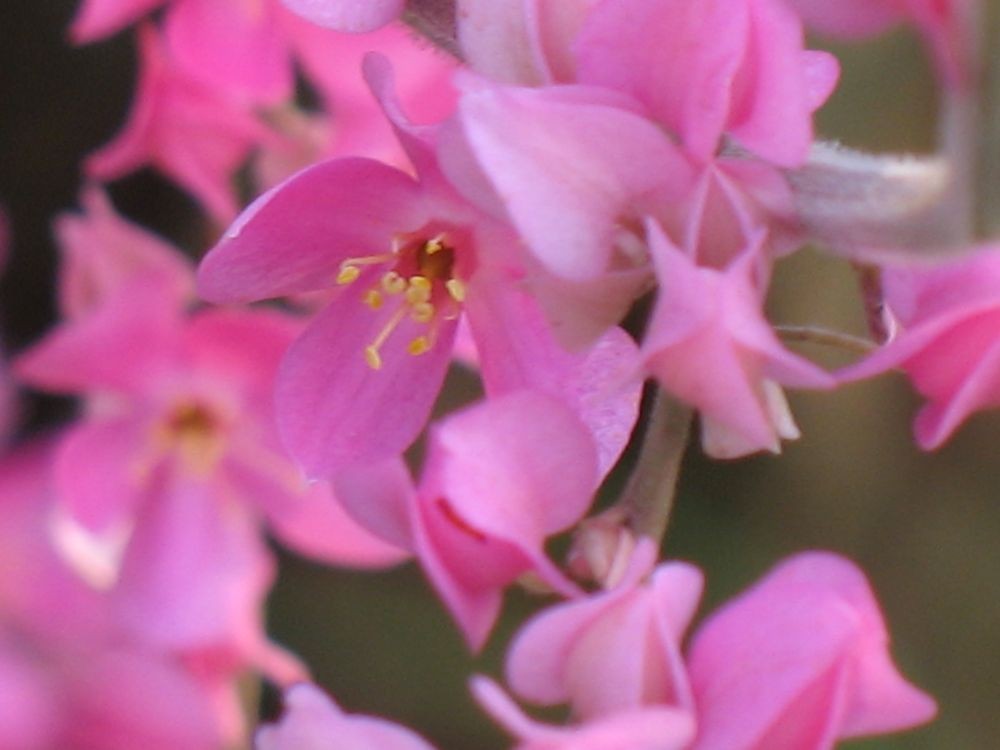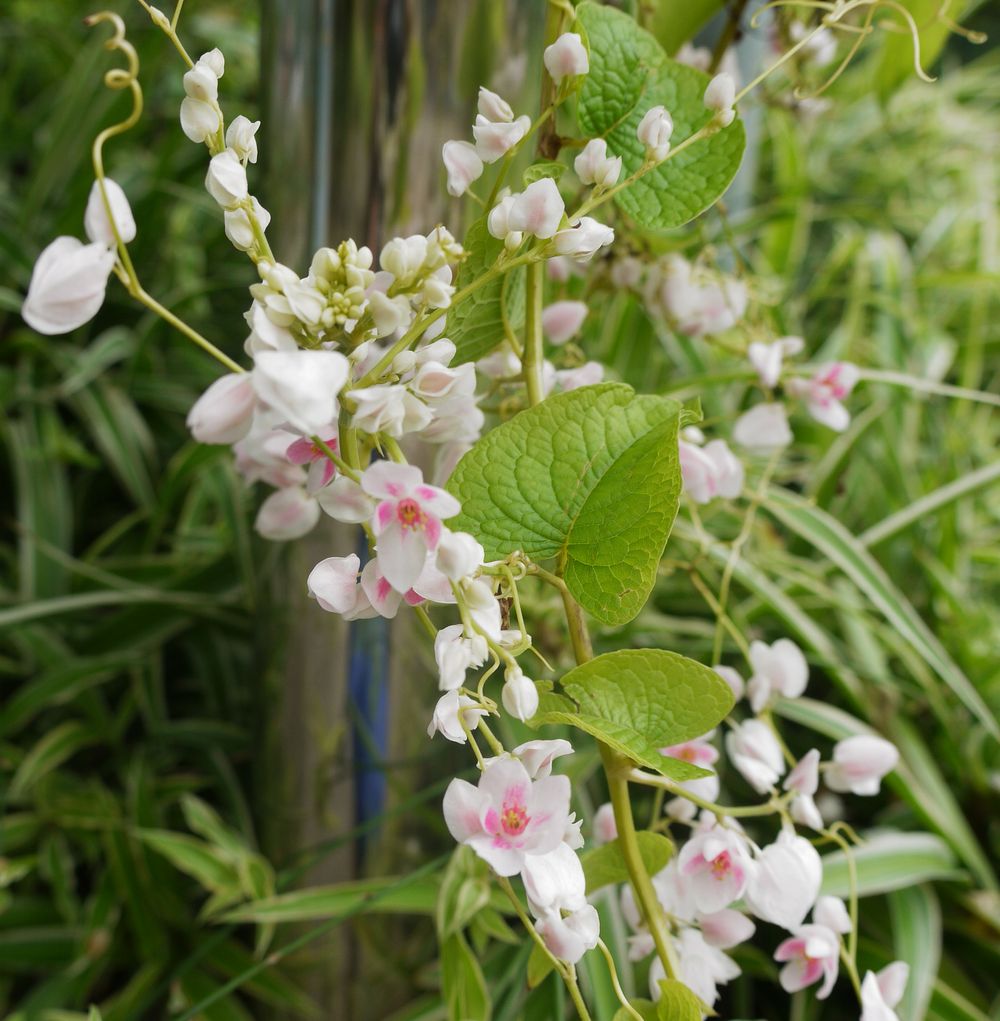This pretty liana comes to us from tropical America (Mexico) from where it naturalized in the majority of the hot areas of the globe to the point of being sometimes invasive. It can climb up to 10m high by hanging with its tendrils. Its leaves are alternate, heart-shaped, a little soft with a wavy edge. Its small flowers which go from pale pink to dark pink and are sometimes white, compose elegant and delicate clusters; throughout the year they cover with their bright color the walls, the trees or the hedges, thus justifying its name of coral liana. Its Latin name, which could make one think of the pretty name “Antigone”, only means that it is “related to Polygonum“, another genus of the same family. The term “leptopus” means “thin stem”. It is perhaps because of these stems which present very marked nodes, that the Lao name this plant ngon naak, which would want to say, according to one of our interlocutors, “neck of Nâga”, but this translation remains to be verified. The Spaniards, with the passion that characterizes them, use the name Amor agarrado, “love that clings”, thus describing the morphology of a vine whose leaves and flower buds are heart-shaped.
In Laos you can see ngon naak climbing on untended hedges or scaling old walls and abandoned houses; no use seems to be made of this vine whose ornamental value is not even noticed. This is not the case with our Thai neighbors, where, we are told, the leaves and flowers, coated with paste, are fried and eaten with vermicelli; the flowers are also put in omelets. The coral liana has a large tuberous root from which the young shoots grow and which is transformed into flour in certain regions of America. In India, leaves and flowers are used to make a refreshing tea.
It is also important to know that, in the race to find bioethanol, chemists in several countries have chosen Antigonon as a possible supplier of the precious component.
Regardless of these considerations, if you have in a corner of your garden this “wild” vine, domesticate it by pruning it regularly, you will have pretty flowers almost all year round and will provide bees with an important source of nectar.
Cette jolie liane nous vient d’Amérique tropicale (Mexique) d’où elle s’est naturalisée dans la plupart des régions chaudes du globe au point d’être parfois envahissante. Elle peut grimper jusqu’à 10m de haut en s’accrochant avec ses vrilles. Ses feuilles sont alternes, en forme de cœur, un peu molles avec un bord ondulé. Ses petites fleurs qui vont du rose pâle au rose foncé et sont parfois blanches, composent des grappes élégantes et délicates; tout au long de l’année elles recouvrent de leur vive couleur les murs, les arbres ou les haies, justifiant ainsi son nom de liane corail. Son nom latin, qui pourrait faire penser au joli prénom « Antigone », signifie seulement qu’elle est « parente des Polygonum », autre genre de la même famille. Le terme « leptopus » signifie, lui, « tige mince ». C’est peut-être à cause de ces tiges qui présentent des nœuds très marqués, que le lao nomme cette plante ngon naak, ce qui voudrait dire, d’après l’un de nos interlocuteurs, « cou de Nâga », mais cette traduction reste à vérifier. Les Espagnols, avec la passion qui les caractérisent, emploient le nom Amor agarrado, « l’amour qui s’accroche », décrivant bien ainsi la morphologie d’une liane dont les feuilles et les boutons floraux sont en forme de cœur.
Au Laos vous pouvez voir ngon naak grimpant sur les haies non entretenues ou escaladant les vieux murs et les maisons abandonnées; aucun usage ne semble être fait de cette liane dont on ne remarque même pas la valeur ornementale. Il n’en n’est pas de même chez nos voisins Thaïlandais, où, nous dit-on, les feuilles et les fleurs, enrobées de pâte, sont frites et mangées avec des vermicelles; les fleurs sont aussi mises dans les omelettes. La liane corail possède une grosse racine tubéreuse d’où repartent les jeunes pousses et qui est transformée en farine dans certaines régions d’Amérique. En Inde on fait avec feuilles et fleurs un thé rafraîchissant.
Il faut savoir également que, dans la course à la recherche de bioéthanol, les chimistes de plusieurs pays ont choisi Antigonon comme possible fournisseur du précieux composant.
Indépendamment de ces considérations si vous avez dans un coin de votre jardin cette liane « sauvage », domestiquez-la en la taillant régulièrement, vous aurez ainsi de jolies fleurs presque toute l’année et apporterez aux abeilles une source importante de nectar.




This pretty liana comes to us from tropical America (Mexico) from where it naturalized in the majority of the hot areas of the globe to the point of being sometimes invasive. It can climb up to 10m high by hanging with its tendrils. Its leaves are alternate, heart-shaped, a little soft with a wavy edge. Its small flowers which go from pale pink to dark pink and are sometimes white, compose elegant and delicate clusters; throughout the year they cover with their bright color the walls, the trees or the hedges, thus justifying its name of coral liana. Its Latin name, which could make one think of the pretty name “Antigone”, only means that it is “related to Polygonum“, another genus of the same family. The term “leptopus” means “thin stem”. It is perhaps because of these stems which present very marked nodes, that the Lao name this plant ngon naak, which would want to say, according to one of our interlocutors, “neck of Nâga”, but this translation remains to be verified. The Spaniards, with the passion that characterizes them, use the name Amor agarrado, “love that clings”, thus describing the morphology of a vine whose leaves and flower buds are heart-shaped.
In Laos you can see ngon naak climbing on untended hedges or scaling old walls and abandoned houses; no use seems to be made of this vine whose ornamental value is not even noticed. This is not the case with our Thai neighbors, where, we are told, the leaves and flowers, coated with paste, are fried and eaten with vermicelli; the flowers are also put in omelets. The coral liana has a large tuberous root from which the young shoots grow and which is transformed into flour in certain regions of America. In India, leaves and flowers are used to make a refreshing tea.
It is also important to know that, in the race to find bioethanol, chemists in several countries have chosen Antigonon as a possible supplier of the precious component.
Regardless of these considerations, if you have in a corner of your garden this “wild” vine, domesticate it by pruning it regularly, you will have pretty flowers almost all year round and will provide bees with an important source of nectar.
Cette jolie liane nous vient d’Amérique tropicale (Mexique) d’où elle s’est naturalisée dans la plupart des régions chaudes du globe au point d’être parfois envahissante. Elle peut grimper jusqu’à 10m de haut en s’accrochant avec ses vrilles. Ses feuilles sont alternes, en forme de cœur, un peu molles avec un bord ondulé. Ses petites fleurs qui vont du rose pâle au rose foncé et sont parfois blanches, composent des grappes élégantes et délicates; tout au long de l’année elles recouvrent de leur vive couleur les murs, les arbres ou les haies, justifiant ainsi son nom de liane corail. Son nom latin, qui pourrait faire penser au joli prénom « Antigone », signifie seulement qu’elle est « parente des Polygonum », autre genre de la même famille. Le terme « leptopus » signifie, lui, « tige mince ». C’est peut-être à cause de ces tiges qui présentent des nœuds très marqués, que le lao nomme cette plante ngon naak, ce qui voudrait dire, d’après l’un de nos interlocuteurs, « cou de Nâga », mais cette traduction reste à vérifier. Les Espagnols, avec la passion qui les caractérisent, emploient le nom Amor agarrado, « l’amour qui s’accroche », décrivant bien ainsi la morphologie d’une liane dont les feuilles et les boutons floraux sont en forme de cœur.
Au Laos vous pouvez voir ngon naak grimpant sur les haies non entretenues ou escaladant les vieux murs et les maisons abandonnées; aucun usage ne semble être fait de cette liane dont on ne remarque même pas la valeur ornementale. Il n’en n’est pas de même chez nos voisins Thaïlandais, où, nous dit-on, les feuilles et les fleurs, enrobées de pâte, sont frites et mangées avec des vermicelles; les fleurs sont aussi mises dans les omelettes. La liane corail possède une grosse racine tubéreuse d’où repartent les jeunes pousses et qui est transformée en farine dans certaines régions d’Amérique. En Inde on fait avec feuilles et fleurs un thé rafraîchissant.
Il faut savoir également que, dans la course à la recherche de bioéthanol, les chimistes de plusieurs pays ont choisi Antigonon comme possible fournisseur du précieux composant.
Indépendamment de ces considérations si vous avez dans un coin de votre jardin cette liane « sauvage », domestiquez-la en la taillant régulièrement, vous aurez ainsi de jolies fleurs presque toute l’année et apporterez aux abeilles une source importante de nectar.








This pretty liana comes to us from tropical America (Mexico) from where it naturalized in the majority of the hot areas of the globe to the point of being sometimes invasive. It can climb up to 10m high by hanging with its tendrils. Its leaves are alternate, heart-shaped, a little soft with a wavy edge. Its small flowers which go from pale pink to dark pink and are sometimes white, compose elegant and delicate clusters; throughout the year they cover with their bright color the walls, the trees or the hedges, thus justifying its name of coral liana. Its Latin name, which could make one think of the pretty name “Antigone”, only means that it is “related to Polygonum“, another genus of the same family. The term “leptopus” means “thin stem”. It is perhaps because of these stems which present very marked nodes, that the Lao name this plant ngon naak, which would want to say, according to one of our interlocutors, “neck of Nâga”, but this translation remains to be verified. The Spaniards, with the passion that characterizes them, use the name Amor agarrado, “love that clings”, thus describing the morphology of a vine whose leaves and flower buds are heart-shaped.
In Laos you can see ngon naak climbing on untended hedges or scaling old walls and abandoned houses; no use seems to be made of this vine whose ornamental value is not even noticed. This is not the case with our Thai neighbors, where, we are told, the leaves and flowers, coated with paste, are fried and eaten with vermicelli; the flowers are also put in omelets. The coral liana has a large tuberous root from which the young shoots grow and which is transformed into flour in certain regions of America. In India, leaves and flowers are used to make a refreshing tea.
It is also important to know that, in the race to find bioethanol, chemists in several countries have chosen Antigonon as a possible supplier of the precious component.
Regardless of these considerations, if you have in a corner of your garden this “wild” vine, domesticate it by pruning it regularly, you will have pretty flowers almost all year round and will provide bees with an important source of nectar.
Cette jolie liane nous vient d’Amérique tropicale (Mexique) d’où elle s’est naturalisée dans la plupart des régions chaudes du globe au point d’être parfois envahissante. Elle peut grimper jusqu’à 10m de haut en s’accrochant avec ses vrilles. Ses feuilles sont alternes, en forme de cœur, un peu molles avec un bord ondulé. Ses petites fleurs qui vont du rose pâle au rose foncé et sont parfois blanches, composent des grappes élégantes et délicates; tout au long de l’année elles recouvrent de leur vive couleur les murs, les arbres ou les haies, justifiant ainsi son nom de liane corail. Son nom latin, qui pourrait faire penser au joli prénom « Antigone », signifie seulement qu’elle est « parente des Polygonum », autre genre de la même famille. Le terme « leptopus » signifie, lui, « tige mince ». C’est peut-être à cause de ces tiges qui présentent des nœuds très marqués, que le lao nomme cette plante ngon naak, ce qui voudrait dire, d’après l’un de nos interlocuteurs, « cou de Nâga », mais cette traduction reste à vérifier. Les Espagnols, avec la passion qui les caractérisent, emploient le nom Amor agarrado, « l’amour qui s’accroche », décrivant bien ainsi la morphologie d’une liane dont les feuilles et les boutons floraux sont en forme de cœur.
Au Laos vous pouvez voir ngon naak grimpant sur les haies non entretenues ou escaladant les vieux murs et les maisons abandonnées; aucun usage ne semble être fait de cette liane dont on ne remarque même pas la valeur ornementale. Il n’en n’est pas de même chez nos voisins Thaïlandais, où, nous dit-on, les feuilles et les fleurs, enrobées de pâte, sont frites et mangées avec des vermicelles; les fleurs sont aussi mises dans les omelettes. La liane corail possède une grosse racine tubéreuse d’où repartent les jeunes pousses et qui est transformée en farine dans certaines régions d’Amérique. En Inde on fait avec feuilles et fleurs un thé rafraîchissant.
Il faut savoir également que, dans la course à la recherche de bioéthanol, les chimistes de plusieurs pays ont choisi Antigonon comme possible fournisseur du précieux composant.
Indépendamment de ces considérations si vous avez dans un coin de votre jardin cette liane « sauvage », domestiquez-la en la taillant régulièrement, vous aurez ainsi de jolies fleurs presque toute l’année et apporterez aux abeilles une source importante de nectar.


